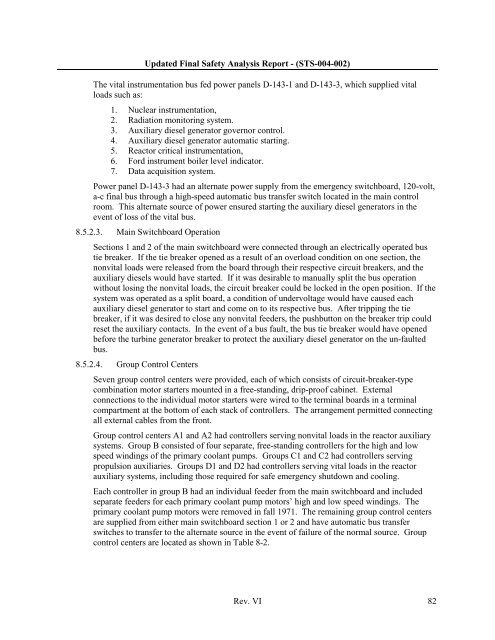10 CFR 50.71(e) - Maritime Administration - U.S. Department of ...
10 CFR 50.71(e) - Maritime Administration - U.S. Department of ...
10 CFR 50.71(e) - Maritime Administration - U.S. Department of ...
You also want an ePaper? Increase the reach of your titles
YUMPU automatically turns print PDFs into web optimized ePapers that Google loves.
Updated Final Safety Analysis Report - (STS-004-002)The vital instrumentation bus fed power panels D-143-1 and D-143-3, which supplied vitalloads such as:1. Nuclear instrumentation,2. Radiation monitoring system.3. Auxiliary diesel generator governor control.4. Auxiliary diesel generator automatic starting.5. Reactor critical instrumentation,6. Ford instrument boiler level indicator.7. Data acquisition system.Power panel D-143-3 had an alternate power supply from the emergency switchboard, 120-volt,a-c final bus through a high-speed automatic bus transfer switch located in the main controlroom. This alternate source <strong>of</strong> power ensured starting the auxiliary diesel generators in theevent <strong>of</strong> loss <strong>of</strong> the vital bus.8.5.2.3. Main Switchboard OperationSections 1 and 2 <strong>of</strong> the main switchboard were connected through an electrically operated bustie breaker. If the tie breaker opened as a result <strong>of</strong> an overload condition on one section, thenonvital loads were released from the board through their respective circuit breakers, and theauxiliary diesels would have started. If it was desirable to manually split the bus operationwithout losing the nonvital loads, the circuit breaker could be locked in the open position. If thesystem was operated as a split board, a condition <strong>of</strong> undervoltage would have caused eachauxiliary diesel generator to start and come on to its respective bus. After tripping the tiebreaker, if it was desired to close any nonvital feeders, the pushbutton on the breaker trip couldreset the auxiliary contacts. In the event <strong>of</strong> a bus fault, the bus tie breaker would have openedbefore the turbine generator breaker to protect the auxiliary diesel generator on the un-faultedbus.8.5.2.4. Group Control CentersSeven group control centers were provided, each <strong>of</strong> which consists <strong>of</strong> circuit-breaker-typecombination motor starters mounted in a free-standing, drip-pro<strong>of</strong> cabinet. Externalconnections to the individual motor starters were wired to the terminal boards in a terminalcompartment at the bottom <strong>of</strong> each stack <strong>of</strong> controllers. The arrangement permitted connectingall external cables from the front.Group control centers A1 and A2 had controllers serving nonvital loads in the reactor auxiliarysystems. Group B consisted <strong>of</strong> four separate, free-standing controllers for the high and lowspeed windings <strong>of</strong> the primary coolant pumps. Groups C1 and C2 had controllers servingpropulsion auxiliaries. Groups D1 and D2 had controllers serving vital loads in the reactorauxiliary systems, including those required for safe emergency shutdown and cooling.Each controller in group B had an individual feeder from the main switchboard and includedseparate feeders for each primary coolant pump motors’ high and low speed windings. Theprimary coolant pump motors were removed in fall 1971. The remaining group control centersare supplied from either main switchboard section 1 or 2 and have automatic bus transferswitches to transfer to the alternate source in the event <strong>of</strong> failure <strong>of</strong> the normal source. Groupcontrol centers are located as shown in Table 8-2.Rev. VI 82
















